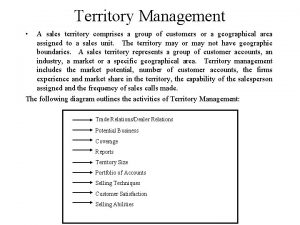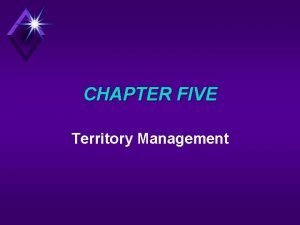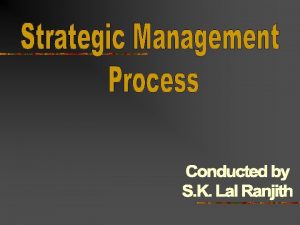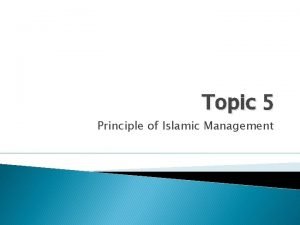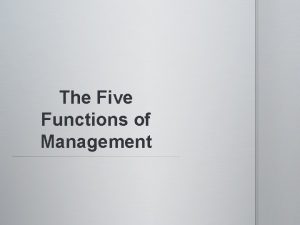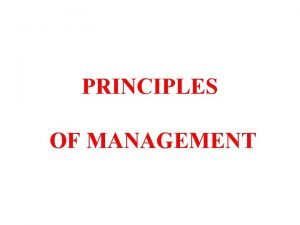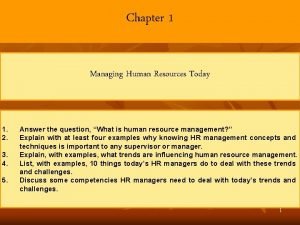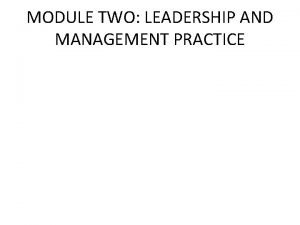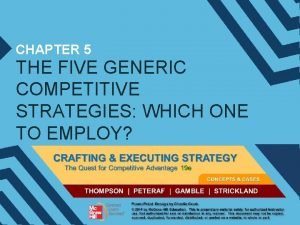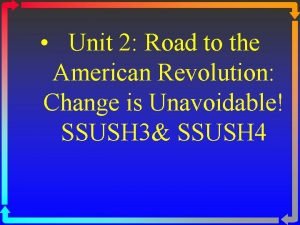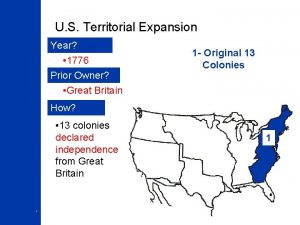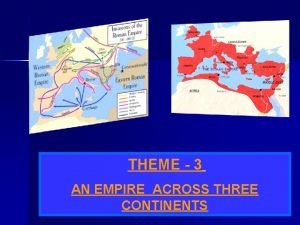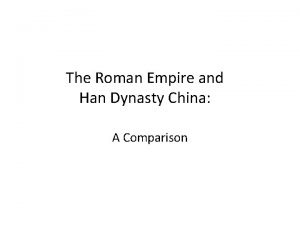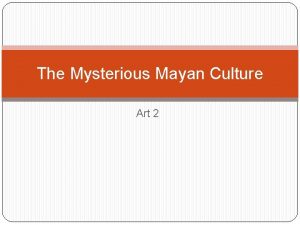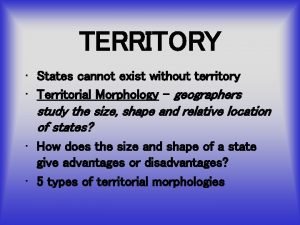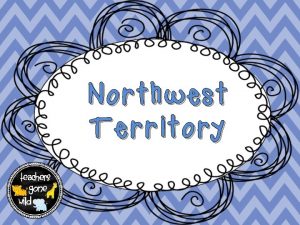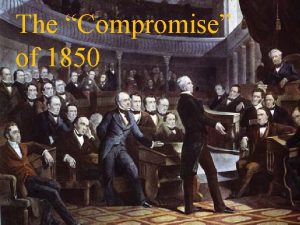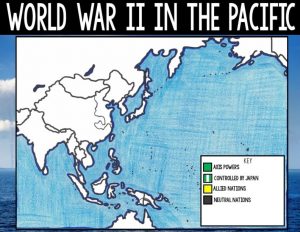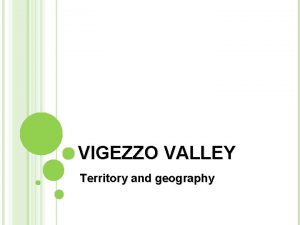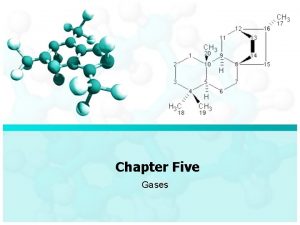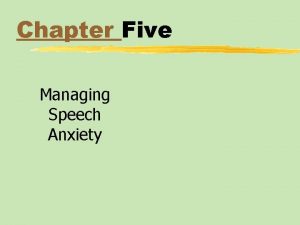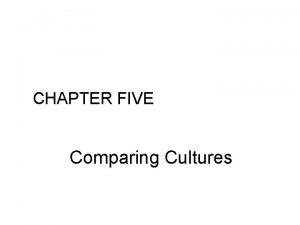CHAPTER FIVE Territory Management TERRITORY u A territory
































- Slides: 32

CHAPTER FIVE Territory Management

TERRITORY u. A territory ugeographically defined area uassigned to a sales person upresent customers upotential customers

SALES FORCE PRODUCTIVITY u. A crisis-u. In the last ten years, selling costs have risen almost twice as fast as average sales volume per salesperson

HOW SALESPEOPLE SPEND THEIR TIME u Face-to-Face Selling = 30% u Telephone Selling = 21% u Waiting / Travelling = 20% u Administrative Duties = 17% u Service Activities = 12%

SALES FORCE PRODUCTIVITY u How can we improve productivity? u. Focus on high volume accounts u. Focus on selling time

MINIMUM ACCOUNT SIZE u Don’t pursue accounts that are unprofitable!!

COST PER CALL u Cost u per call is a function of unumber of calls per day unumber of days available to make calls udirect selling expenses Direct Selling Expenses # Calls per day X # Days to Sell

COST PER CALL u Example (see Table 5. 1; page 230) u Total Direct Expenses = $90, 250 u 205 days to sell; average 3 calls per day u Cost per call = $90, 250 / 205 x 3 = $146. 75

BREAK EVEN SALES VOLUME u The sales volume necessary to cover direct selling expenses u Breakeven Volume is a function of: u Cost per call u Number of calls to close u Sales costs as a percentage of sales

BREAK EVEN SALES VOLUME Cost Per call X # of Calls to Close Sales costs as a % of Sales

BREAK EVEN SALES VOLUME See Table 5 -2; page 231 Electronics Industry --Cost per call = $133. 30 --Number of calls to close = 3. 9 --Sales Costs as a % of sales = 12. 0 Breakeven volume = $133. 30 x 3. 9 /. 12 = $4, 332. 25

TERRITORY IMPLICATIONS u Perform a customer by customer analysis! u Assess selling strategy

ALLOCATION OF SELLING EFFORT u Consider the time we spend with customers! u Single Factor Models u Portfolio Models u Decision Models

SINGLE FACTOR MODELS u Easy to develop and use u Classify accounts into categories based on one factor, such as market potential u Assign all accounts in the same category the same number of sales calls u Decisions are made on the basis of one factor. Differences among

SINGLE FACTOR MODEL

PORTFOLIO MODELS u Accounts are classified into categories of similar attractiveness for receiving sales call investment. u Selling effort is allocated so that the more attractive accounts receive more selling effort.

ACCOUNT ATTRACTIVENESS u Account Opportunity u The account’s need for and ability to purchase the product u High / Low u Competitive u The Position strength of the relationship between the firm and the account u Strong / Weak

PORTFOLIO MODEL SEGMENTS u Strong Competitive Position/High Account Opportunity u “Core Accounts” u Accounts are very attractive due to strong competitive position u Accounts should receive a heavy investment of selling effort to maintain/improve competitive position

PORTFOLIO MODEL SEGMENTS u Weak Competitive Position/High Account Opportunity u “Growth Accounts” u Accounts are potentially attractive due to high opportunity u Additional analysis required to identify accounts where competitive position can be improved. Target these accounts

PORTFOLIO MODEL SEGMENTS u Strong Competitive Position/Low Account Opportunity u “Drag Accounts” u Accounts moderately attractive; future opportunities are limited u Accounts should receive an effort sufficient to maintain current position

PORTFOLIO MODEL SEGMENTS u Weak Competitive Position/Low Account Opportunity u “Problem Accounts” u Accounts very unattractive u Accounts should receive a minimal of selling effort. Less costly forms of marketing might be considered (telemarketing, direct mail) and/or the elimination of account coverage

PORTFOLIO MODEL EXAMPLE

DECISION MODELS u Examine accounts on an individual basis u Allocate sales calls to accounts that promise the highest sales returns u The objective is to achieve the highest level of sales and to increase sales calls until marginal costs equal marginal returns

DECISION MODEL EXAMPLE

MANAGING TERRITORY PROFITABILITY u Allocation of Effort u Mix of Products Sold u Price Concessions

ROUTE MANAGEMENT u Route should be circular u Route should never cross itself u Don’t use same route to go to and from a client u Customers in neighboring areas should be visited in sequence

TIME MANAGEMENT u Telephone interruptions u Drop in visitors u Crises u Meetings u Lack of objectives u Indecision/procrastination u Poor communications

TIME MANAGEMENT u Get control of your time! u. Set goals and objectives u. Set priorities u. Develop a daily “to do” list u. Focus on the most important tasks

MANAGEMENT’S ROLE u Close Supervision u Hands-off Management u Management Recommendations

FROM THE INTERNET u The granddaddy of time management sites: u http: //www. relibrary. com/10 tm 1. htm

FROM THE INTERNET u See what a consultant says about improving sales force productivity at: http: //www. brickerinc. com/netgain. ht m

FROM YOUR TEXT u Read everything in chapter five except upages 238 to 240 (Sales Funnel Method) upages 242 to 245 (Largest Angle Method)
 And now with gleams of half-extinguished thought
And now with gleams of half-extinguished thought Five of five
Five of five 5 senses and 5 elements
5 senses and 5 elements Macbeth seyton i am sick at heart
Macbeth seyton i am sick at heart A sales territory comprises:
A sales territory comprises: Sales territory management best practices
Sales territory management best practices Territory management model
Territory management model Chapter 4 from territory to early statehood vocabulary
Chapter 4 from territory to early statehood vocabulary Top management middle management first line management
Top management middle management first line management Top management middle management first line management
Top management middle management first line management Middle level management
Middle level management Five tasks of strategic management
Five tasks of strategic management Five (5) principles of islamic management.
Five (5) principles of islamic management. Five management functions
Five management functions Function of management
Function of management New approaches to organizing hr
New approaches to organizing hr 7 steps of portfolio process
7 steps of portfolio process Five management practice
Five management practice Chapter 12 inventory management
Chapter 12 inventory management Chapter five great gatsby summary
Chapter five great gatsby summary Five generic strategies
Five generic strategies Oral pathology
Oral pathology Chapter five animal farm
Chapter five animal farm What is a territory
What is a territory Greek and roman geography
Greek and roman geography Ohio valley territory
Ohio valley territory Florida cession prior owner of territory
Florida cession prior owner of territory An empire across three continents notes
An empire across three continents notes Czar in russian revolution
Czar in russian revolution Dynasty vs empire
Dynasty vs empire Mayan territory
Mayan territory Aurangzeb territory
Aurangzeb territory Prewar boundaries 1754
Prewar boundaries 1754




